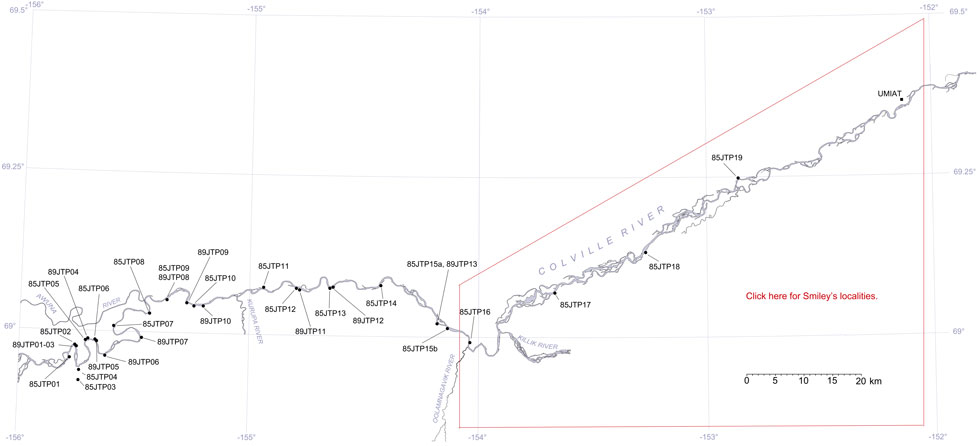Upper Colville River, Alaska
| Map of Northern Alaska | Upper Colville Fossil Images Unassigned | No Fossil Images |
|---|
This interactive map of part of the Colville River, Northern Alaska, shows the locations of plant fossil collections made by J.T. Parrish and R.A. Spicer in 1985 and 1989. Click on a number for more details on that site. The red outlined area links to another map showing positions of florules (plant fossil assemblages) collected by C.J. Smiley along both the Colville and Chandler Rivers. |

Locality 89JTP06
Description:
Here marine units pass up into heavily rooted brown/gray nodular siltstones with abundant rooting much of which is formed by Equisetites rhizomes. The seat earths and paper shales of the coals in this section contain Podozamites, Equisetites and Cephalotaxopsis, together with woody (branch) debris and occasional logs. Pityophyllum is less abundant but present. This section was not studied in 1985 because our boat was already overloaded with samples and a suitable resupply landing site needed to be found.
The lower part of the section is poorly exposed. The well exposed part of the section begins with a claystone/siltsone with intercalated fine sandstones with invertebrate trails, burrows and flute casts. The bioturbation style is the same as that in the marine beds of 85JTP05 that contain undeniably marine fossils such as ophioroids.
 |
These marine(?) units pass up into heavily rooted gray siltstones with abundant Equisetites rhizomes. This is overlain by mottled brown/gray nodular, poorly bedded silts and clays that are abundantly rooted. These are interpreted as overbank sediments. Above these are several meters of unconsolidated clays with small ironstone nodules capped by a 0.1m thick rooted sandstone. Bedding planes of the sandstone are covered in poorly oriented water-worn woody fragments representing transported twigs. Some Equisetites stems/rhizomes also present. This in turn is overlain by two distinct rooted coarse siltstones beneath a seat earth of a coal. The lower part of this coal is papery with remains of Equisetites, abundant Podozamites and small conifer leafy shoots probably representing Cephalotaxopsis. Pityophyllum staratchinii is present but uncommon. The coal in total is several meters thick but contains numerous clay/silt partings and is often more of a paper shale. Numerous large compressed logs > 0.3 m in diameter are present and Podozamites leaves are abundant throughout. The coal is overlain by a pedogenically modified clay preserving tree roots, which is in turn overlain by 1 m thick nodular siltstones capped by cross bedded sands overlain by a nodular siltstone containing Equisetites rhizomes. Approximately 5 m above is an inferred non-marine/marine transition.
Sketch of the 89JTP06 section. |
| Field photograph of an in situ tree base from the 89JTP06 section. The clay containing the tree base is covered by slope wash. |  |
